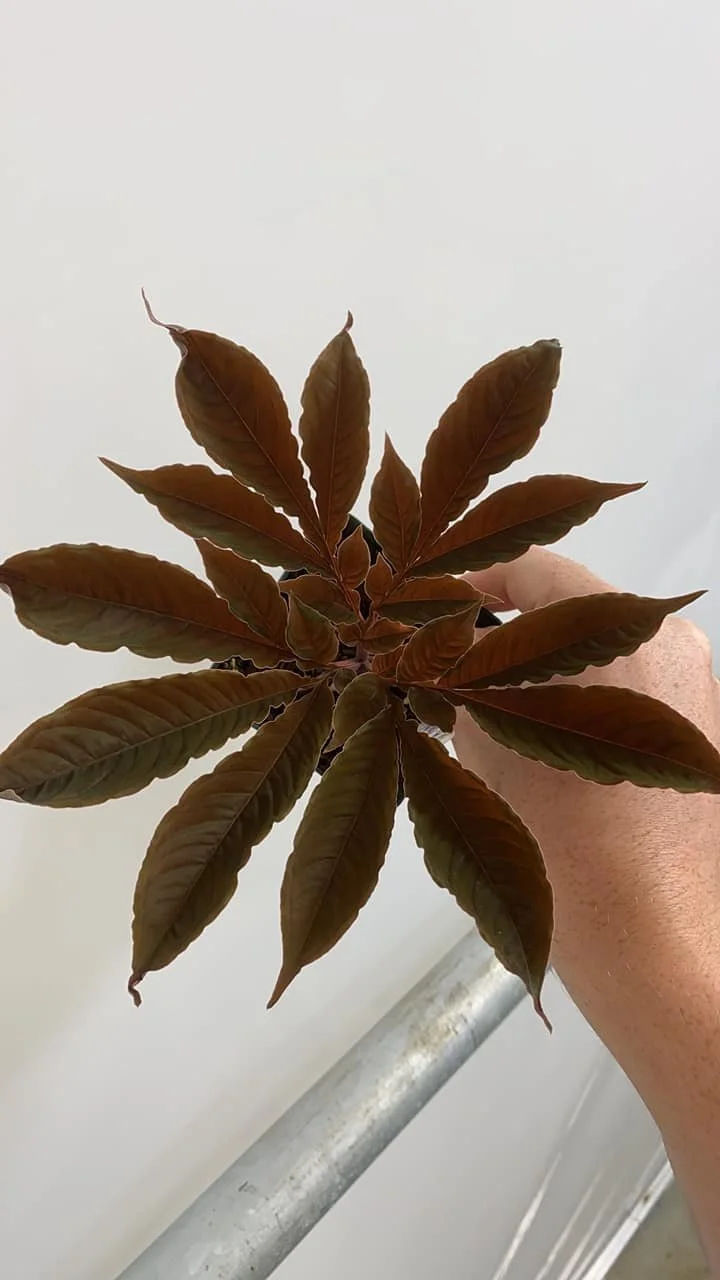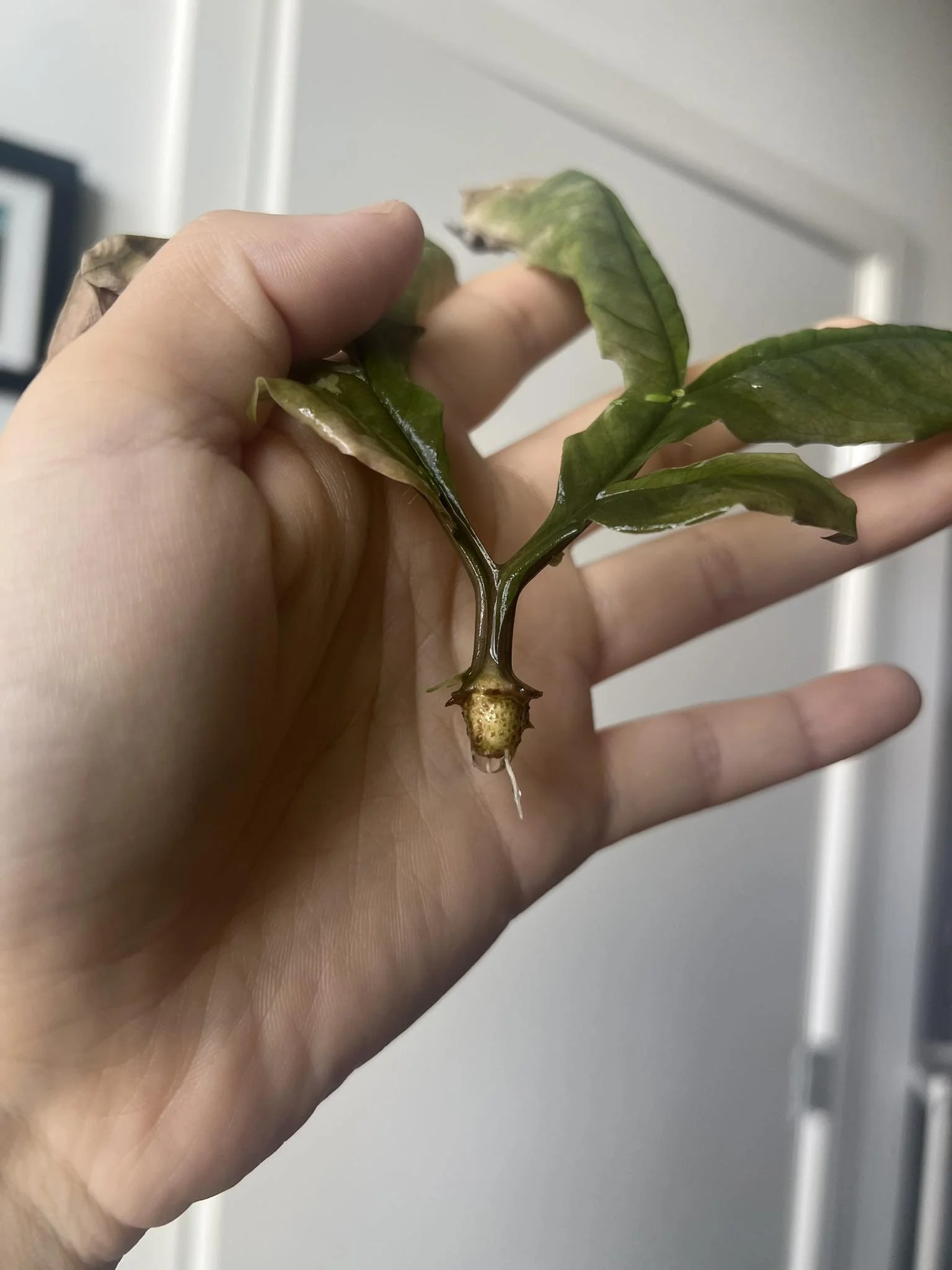AMORPHOPHALLUS BARBATUS
ORIGINAL DESCRIPTION:
Amorphophallus barbatus A.Galloway & A.Ongsakul sp. nov.
Type: from a plant cultivated by A. Galloway (orig. coll.: LAOS, Khammouane Province, in shaded areas among limestone boulders A. Galloway), 29 April 2012, Galloway AGA-2309-01-T (holotype, QBG, spirit collection). Figs. 1–4.
Aroideana 38 (2015) P.3
Photo by Chanon Limtaropas
SYNONYMS:
HOMOTYPIC SYNONYMS: N/A
HETEROTYPIC SYNONYMS: N/A
ACCEPTED INFRASPECIFICS: N/A
DISTRIBUTION: Laos
CLIMATE: N/A
ECOLOGY: Shaded areas among limestone boulders
SPECIES DESCRIPTION:
Tuber depressed globose, 4–6 cm in diam., 3–5 cm high, brown, no offset development. Leaf solitary; petiole 25–35 cm long, 1 cm in diam., very dark burgundy to near black, longitudinally ridged; lamina moderately dissected, up to 40 cm wide, rachises winged; leaflets elongate elliptic, acute acuminate, 7–14 cm long, 1.5–3 cm in diam., upper side dark blackish green, margin bright pink, lower side pale grayish green with pale burgundy venation.
INFLORESCENCE:
Inflorescence solitary; peduncle as petiole 8–10 cm long, 1 cm in diam.; spathe elongate triangular, 15–21 cm long, 7–8.5 cm wide, base and limb separated by a shallow constriction, outside pale grayish pink with brown venation, inside lower half burgundy, densely clothed with conical irregular warts; inside upper half pale grayish pink with brown venation. Spadix longer than spathe, 22–41 cm long, 1–1.5 cm in diam.; stipe 1 cm long, 1–1.5 cm in diam., pale burgundy; female zone cylindric, 1–1.5 cm long, 1–2 cm in diam. (incl. styles), flowers slightly distant; male zone cylindric, 2.5–3 cm long, 1–1.5 cm in diam., flowers congested with scattered hair-like, burgundy staminodes in between the functional flowers; appendix elongate conic, acute, 17–36 cm long, 1–1.5 cm in diam. at base, burgundy, surface with scattered hair-like, burgundy staminodes, 1 cm long. Ovaries depressed, circular in cross-section, ca. 1.5 mm high, ca. 2 mm in diam., dark burgundy, bilocular; style ca. 3.25 mm long, ca. 1 mm in diam., terete, dark burgundy; stigma oval in crosssection, subcordate in longitudinal section, ca. 0.75mm high, ca. 2mm in diam., deeply 2–3 lobed, surface echinulate, gray. Male flowers consisting of 2–4 stamens; stamens ca. 2 mm long, creamy-white; filaments ca.1.8 mm long, connate; anthers sessile, truncate, ca. 1 mm in diam.; pores apical.
VARIEGATED FORMS: N/A
ETYMOLOGY: The epithet of this species refers to the dense hair-like staminodes on the spadix
NOTES:
Amorphophallus barbatus is certainly one of the more stunning ornamental species with its near black petiole and leaf, comparable to Amorphophallus pygmaeus, Amorphophallus gallowayi, Amorphophallus saururus, and Amorphophallus atroviridis. In pot culture, Amorphophallus barbatus prefers to be stored dry during dormancy.
Amorphophallus barbatus is one of five species having densely hairy, elongated appendices. The other species sharing this trait are: Amorphophallus hirtus N.E.Br. (Taiwan), Amorphophallus longicomus Hett. & M. Serebryanyi (Vietnam), Amorphophallus natolii Hett., A. Wistuba, V.B. Amoroso, M. Medecilo & C. Claudel (Philippines), and Amorphophallus pilosus Hett. (Vietnam). Amorphophallus barbatus differs from Amorphophallus hirtus, Amorphophallus longicomus, and Amorphophallus pilosus in being short peduncled, whereas the latter are all long peduncled. Amorphophallus barbatus differs from Amorphophallus natolii in having a constricted spathe between base and limb, the latter not having a constricted spathe. The leaflets of Amorphophallus barbatus have bright pink margins, whereas this feature is absent in Amorphophallus natolii. Amorphophallus barbatus is unique among all species having a hairy spadix by being the only species to have a longitudinally ridged petiole and peduncle.
CULTIVARS: N/A
HYBRIDS: N/A
REFERENCES:
Aroideana 38 (2015) P.3
Photos by Chanon Limtaropas, Jacob James, Martin Oravec, Valdemar Maximo, and Xue Davis
















































